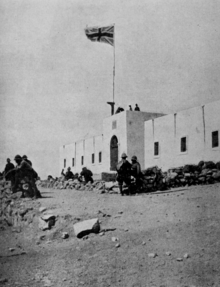Occupation of Sollum
| date | December 22, 1911 |
|---|---|
| place | Sollum |
| Casus Belli | Smuggling of war materials and illegal border crossings into the war region |
| output | British occupation |
| Parties to the conflict | |
|---|---|
| Commander | |
|
George Hunter |
unknown |
| Troop strength | |
| 355 men | about 25 men |
| losses | |
|
no |
no |
The occupation of Sollum was the enforcement of the British claim to the Ottoman-controlled place Sollum during the Italo-Turkish War . The place was then on the western border with Egypt . After negotiations, Sollum was occupied by Anglo-Egyptian troops on December 22nd, 1911. After the Italo-Turkish War, the Ottoman provinces in Libya were claimed by Italy . The annexation of Sollum in favor of British-controlled Egypt was contractually fixed in 1925 as part of the Milner-Scialoja Agreement with Italy.
background
With the occupation of Sollum , the British pursued the ostensible purpose of being able to better control the border region in order to maintain neutrality in the Italo-Turkish war. However, the British government raised the claim to Sollum for Egypt as early as 1904 and secured approval from Italy in 1907.
Unresolved border issue
Since 1882 Egypt was under indirect British administration, but officially remained a sub-state of the Ottoman Empire (→ British rule in Egypt ), which is why a demarcation from Ottoman Libya was neither negotiated nor contractually fixed. In fact, the port of Sollum formed the border with Egypt. At that time the port of Sollum was one of the most important in eastern North Africa and was well fortified by a fort - despite its primitive condition. At the beginning of the Italo-Turkish War the Ottoman garrison of the fort consisted of around 25 men. The Ottoman Empire set the actual border in its opinion about 200 km east from Sollum to Cape Ras el Kanais with reference to a Ferman issued by the Ottoman Sultan in 1841 , in which the borders of the Ottoman province of Egypt were determined.
smuggling
Due to the Italian blockade of the Libyan coast, it was impossible for the Ottoman Empire to send major support from the motherland to the troops in the Libyan provinces by sea. The British government declared its neutrality in the Italo-Turkish War and thereby undertook not to support any warring party in military or economic matters. However, this status was in jeopardy, because Ottoman soldiers and officers, Egyptian volunteers and war materials came across the borders of Egypt into the war zone. After Italian complaints, the British increased their border controls.
course
After the outbreak of the Italo-Turkish War, the British Consul General of Egypt , Herbert Kitchener , made preparations for the occupation of Sollum. There he sent a division of the Coast Guard (150 men and 155 camel riders) under the direction of their General Director George Hunter, and a division of the Egyptian Army (50 men) under the command of Captain Henry Kyrke. After negotiations on December 20, 1911, the Ottoman garrison agreed to leave the place and the fort, and on December 21, moved to a camp set up by the Anglo-Egyptian troops about 3 km west of the fort. The next day the fort occupied by the Anglo-Egyptian forces.
consequences
A contractual clarification of the status of Sollum with the Ottoman Empire did not take place, as the latter had to renounce the possessions in Libya due to the defeat in the Italo-Turkish War. During the First World War , Sollum was once again occupied by the Ottoman Empire as part of the invasion of Egypt by Nuri Killigil from November 23, 1915 until it was reconquered by Anglo-Egyptian troops on March 14, 1916. With the Milner-Scialoja Agreement of December 6, 1925, the border between Egypt and the Italian colonies in Libya was fixed, whereby Sollum was also formally awarded to Egypt.
supporting documents
- ↑ a b [nn]: The political and strategic importance of Sollum, p. 13, In: Allgemeine Schweizerische Militärzeitung. Organ of the Swiss Army. Verlag Zofinger Tagblatt, Basel, 57.1912, No. 1, pp. 13-14.
- ↑ a b [nn]: The political-strategic importance of Sollum, p. 14. In: Allgemeine Schweizerische Militärzeitung. Organ of the Swiss Army. Verlag Zofinger Tagblatt, Basel, 57.1912, No. 1, pp. 13-14.
- ^ A b c Simon, Rachel: Libya between Ottomanism and Nationalism. The Ottoman Involvement in Libya during the War with Italy (1911-1919). Berlin 1987, p. 45.
- ↑ Simon, Rachel: Libya between Ottomanism and Nationalism. The Ottoman Involvement in Libya during the War with Italy (1911-1919). Berlin 1987, p. 111.
- ↑ McGuirk, Russell: The Sanusi's Little War. The Amazing Story of a Forgotten Conflict in the Western Desert. 1915-1917. London 2007, p. 29.
- ↑ Simon, Rachel: Libya between Ottomanism and Nationalism. The Ottoman Involvement in Libya during the War with Italy (1911-1919). Berlin 1987, p. 114.
- ↑ McGuirk, Russell: The Sanusi's Little War. The Amazing Story of a Forgotten Conflict in the Western Desert. 1915-1917. London 2007, p. 27.
- ^ A b c McGuirk, Russell: The Sanusi's Little War. The Amazing Story of a Forgotten Conflict in the Western Desert. 1915-1917. London 2007, p. 28.
- ↑ Timelines for Events of the League of Nations from 1918 to 1946 ( Memento of September 24, 2015 in the Internet Archive ), accessed on February 28, 2014.
